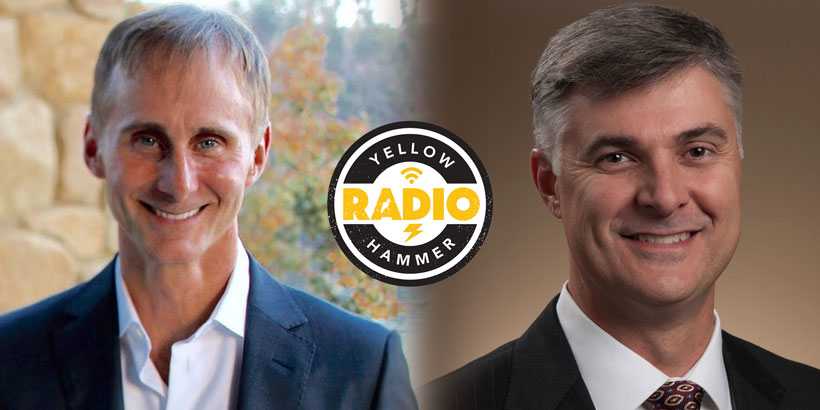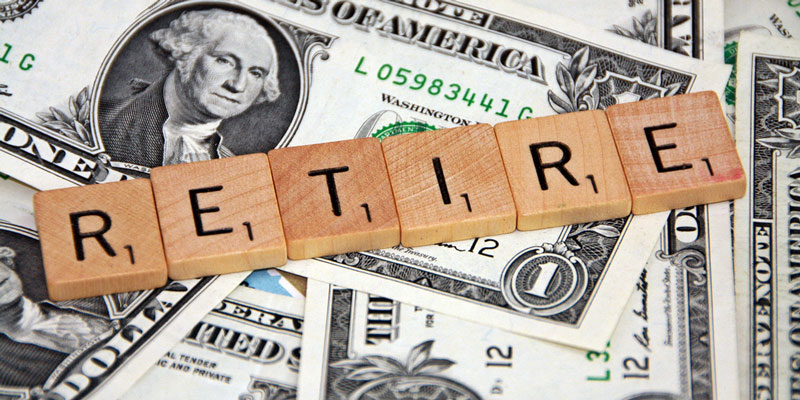Birmingham, Alabama-based financial guru Jeff Roberts, who was recently named one of the top private wealth advisors in the nation by Barron’s®, came on Yellowhammer Radio Tuesday to lay out the facts so people can decide for themselves.
The full conversation with Mr. Roberts can be heard on the Yellowhammer Radio podcast or in the video above, and a lightly edited transcript of his interview with Yellowhammer’s Scott Beason can be read below.
Subscribe to the Yellowhammer Radio Podcast on iTunes. Learn more about Jeff Roberts’ private wealth advisory practice at JeffRobertsAndAssociates.com.
Scott:
I know you’re going to finish up with some of the stuff we talked about last week. We were talking about retirement, how we make that happen, the different phases of it. This is a subject we’re all going to have to master or we’ll face significant problems down the road. I may be one of those people. Can you catch us up a little bit? Can you recap last week, what were the highlights?
Jeff:
Certainly. We learned last week that there are two phases of retirement planning. First there is the accumulation phase, which is where it involves planning for retirement before you retire. The accumulation of savings. Secondly there’s the distribution phase, which occurs during retirement. Often times when people are distributing savings from their nest egg to cover living expenses. And last week we drilled down specifically on the accumulation phase a good bit and we learned that a good retirement obviously does not just happen. It has to be very carefully planned out and we only get one shot at it. Remember that the goal is to get to a point where work is optional and retirement is affordable. Today we’re going to discuss the second half of retirement planning and that is the distribution phase.
Scott:
So distribution is how we’re going to spend our money when we’re retired, I guess. So what do we need to know about the distribution phase, Jeff?
Jeff:
You’re right. And again, as I explained last week many people think that retirement planning is only for people that have not yet retired and this is not at all true. Getting to retirement is just half of the planning. The rest occurs during retirement itself. There is a tremendous amount of work that must occur in retirement.
Scott:
Work? Jeff, I was planning on not working in retirement. What do you mean by “work”?
Jeff:
In this case I’m really speaking of financial planning work not necessarily employment work. And the point of retirement of course is not to have to work but you bring up a good point. Many people are choosing to work in retirement. Let me give you some background on that. For decades Americans had three legs to the retirement stool. One leg is a company pension that paid an income for life after working your entire life for a particular company. Another leg to the stool would be social security retirement benefits and like it’s sister, the pension plan, you would receive from social security as you do now an income for life. And the third leg to the retirement stool is what people may accumulate on their own. Their personal savings outside of work. Now today most companies no longer provide pension benefits or defined benefit plans, where you receive an income for life. Those were traded in for things like 401k plans and if you’re a nonprofit organization, things like 403b plans. So there’s really, with only two legs to that retirement stool, being a personal savings and a 401k plan and social security that changes things you really have to maximize your years in the accumulation phase. So if you add it all up, pensions are gone mostly. Social security is likely going to be paying less not more, most people agree with that. People aren’t really saving enough into things like their 401k plan and we’re living longer. So for some people that may mean retiring from their job or career and then transitioning to another job that may be something that they actually love with all their hearts. And I’ve seen people retire who’ve earned $100,000 – $200,000 or more but then they go on to do something where they only earn a fraction of that amount but they’re passionate about what they do, they stay active in retirement, and they’ve created a third leg to their retirement stool of having a little bit of part time work that comes in.
Scott:
So tell us more about this financial work in retirement that people need to be thinking about.
Jeff:
Here’s how I explain this to clients in retirement or entering retirement. I want you to picture a bucket. You know the one, a galvanized metal bucket with a handle on it. You can probably buy them at Home Depot. during the accumulation phase the emphasis is on putting money into the bucket and filling up our water level almost to the top. That’s your nest egg. So when our bucket is full of savings we enter the distribution phase and if you only have two legs to your retirement stool, which is your savings and your social security, then you may need to start taking some income off of your bucket. So you attach a spigot to the bucket down at the bottom and your bucket is hopefully full of savings. So here is the important part of the planning work in retirement. Very, very important. We both know that if you go to that spigot and you just crank it open as far as it’ll go the contents of that bucket will come flowing out overwhelmingly. And the water level of the bucket will drop precipitously. In no time at all your bucket will be half empty. So retirement planning in retirement, the distribution phase is about spigot control and as a rule of thumb, generally you should not plan to distribute more than 4% of your nest egg on an annual basis. 4% coming out of the bucket on an annual basis. And in low interest rates environments like what we’re experiencing right now it may be necessary to target only a 3% annual distribution if you want your money to last throughout your lifetime.
Scott:
So Jeff, you’re talking about only 3% or 4% what’s significant about those numbers? Why do you pick those numbers out?
Jeff:
In the distribution phase, actually retired, you have many important issues to consider. Here are three in the form of a question. This is very important. How much money do you need to take out of your nest egg to live comfortably during retirement? What is inflation? How much is inflation right now? And then, how much is my portfolio growing on an annual basis? Or in some cases, not growing. So, how much money do I need to take out of my bucket? What is inflation? And what is my portfolio growing by? The answer to the first two questions tells us the answer to number three and what it needs to be. So lets play with the numbers for example. So for question number one, how much money do I need to take out of my nest egg to live comfortably in retirement? Well let’s assume for purposes of our conversation that you need to be distributing the full 4% out of your nest egg, out of your bucket. Turn the spigot on and the 4% comes out. Question number two, what is inflation, the wear and tear on my dollar? Let’s assume inflation is at 2%. So if my income distribution, my nest egg is spitting out 4% to cover the expenses plus a 2% inflation that means your portfolio has to grow at 6% just to break even. And as an advisor I’m going to ask that person in that situation, “Where are you going to get a consistent return of 6% on your portfolio year after year being in retirement? And what happens in years that your portfolio doesn’t grow at 6%?” Let’s say markings actually decline by 6%, then what do you do? So people in retirement need to be adjusting the amount of their income distributions base on the size of their portfolio as it ebbs and flows. Let me give you an example. Take a million dollar portfolio, if you’re lucky enough to have a million bucks. Let me use a big round number so it’s easier. So if you have a portfolio of a million bucks and let’s say you take out 4% income distribution, that’s $40,000 you’re taking out of the portfolio. Now, let’s assume the portfolio declines by 10% and that’s due to the market falls 6% and you’re taking out your 4% distribution so those two combined cause the portfolio to be down 10%. So your million bucks goes to $900,000 left in your portfolio. So if you still pay out $40,000 which was 4% of the original amount. That’s no longer a 4% distribution, that’s a 4.44% distribution. So you’re taking the same amount of money dollar amount wise nut it’s a higher percentage of the smaller number and that’s where you have to be really careful. You’re distribution then should be adjusted. Now you should only take 4% of $900,000 which is $36,000 a year where originally we were taking out $40,000 a year. So remember, basically safely pick a piece of fruit off of your tree but you don’t want to break a branch when you’re in retirement.
Scott:
That makes a lot of sense. Some people think they have to retire and they’re set on this automatic schedule and they’re just taking this money out and if you’re not watching it closely you can end up taking out too much because you’re not paying too much attention to your portfolio. I understand that inflation can be a problem, so what does that mean to people in retirement? Because I understand not taking out too much on my own but I think when inflation begins to start muddying the waters a little bit.
Jeff:
It’s a very important piece. Inflation is a general increase in prices and a fall of purchasing power of money and it’s the silent killer. Inflation right now is around 1% or so today which is very low historically. Since the 1920’s if you look at long term averages, inflation is really averaged about 3% historically. So when we’re doing forecasting with clients we generally assume a 3% number verses where we actually are today is kind of a little low. So at 3% inflation means prices of goods and services are going to double on average about every twenty-four years. So whatever your nest egg is worth on the first day of your retirement, it will have to be worth twice that amount twenty-four years later assuming a 3% average inflation. All while carving you off income distributions so that you can enjoy your retirement each year.
Scott:
That’s something I had not thought about. So you have to retire with large amounts of savings. Live off a small portion of your nest egg. Grow your retirement savings to compete with the impact of inflation. All while managing to adjust your living income as your portfolio naturally increases or decreases. How do you do all that in retirement?
Jeff:
It’s a lot. My suggestion is you work with my team. We develop long term relationships with clients that are going to last throughout retirement because this kind of planning spans again over your entire life before and during retirement. By working together the goal is to help clients to know what questions to ask, know what problems may lie ahead and know what adjustments they need to be making. and our goal is for clients to live in retirement with financial confidence and we believe that comes with a relationship with our firm.
Scott:
Jeff what are some of the most common mistakes that people make in this distribution phase?
Jeff:
I’ll ramble off a few bullet points and they’re in random order. Number one, carrying too much debt in retirement. In my opinion debt at all in retirement. People should be as debt free as possible when they want to retire. People being unaware of the risk exposure in their portfolio. As you are retired you better be crystal clear on the components of your portfolio that can create the most volatility and making sure regularly you’re adjusting your portfolio to make sure it doesn’t creep in risk in the wrong direction. Three would be enabling dependent or financially irresponsible children. We see a tremendous amount of this from people in retirement that are still just paying the bills or helping out people that are just financially irresponsible and that often times doesn’t improve. Four is taking social security retirement benefits too early. The longer you delay social security, generally speaking, will increase about 8% on an annual basis if you don’t take them. So if I don’t take my benefits at age 65 and I take them at 66 I just got an 8% raise in my social security benefits. If I delay it from 66 to 67 I get an 8% raise in my social security benefits. Take them too early you lose some growth of your benefits. Number five would be not implementing a tax plan to harvest IRA qualified money assets that are sometimes in lower tax brackets. Sometimes that’s possible for some people. Pulling income distributions too large for their nest egg to possibly be able to support is another issue. Kind of what we talked about when people turn the spigot on to much. Failing to adjust the retirement income distributions that they’re making in years where the market of their portfolio is down or has dropped in value. And not protecting the sales against incredibly high costs of long term care that can stem from an illness or an injury while being retired. I also think another common mistake is not working with someone to help address all these issues that we just talked about.
Scott:
Jeff one thing that you brought up today that I had not thought about, when I look at retirement planning, when I hear people talk about retirement planning it’s always in that accumulation phase. And it sounds like you’re making the point and I see it now and I didn’t before. Having someone to help me during retirement. I’ve already done all of this, I think, but having you guy’s help during retirement is going to be a huge help. Any last thoughts, Jeff, before we wrap up today?
Jeff:
Yes, thank you and I agree. It’s usually because when people hit that milestone of retirement they believe that what they’ve got and the income that they’re going to be able to create fits right in at age 60, 65, whatever. They’re not thinking about 25 – 35 years down the road in retirement and that doubling impact of inflation on their expenses. And is their portfolio as well as they’re trying to do in retirement going to able to account for that. It’s incredibly important. As I said last week and hear it again clearly, good retirement does not just happen whether you’re in it or before it, it has to be planned out. Again, before and during.













